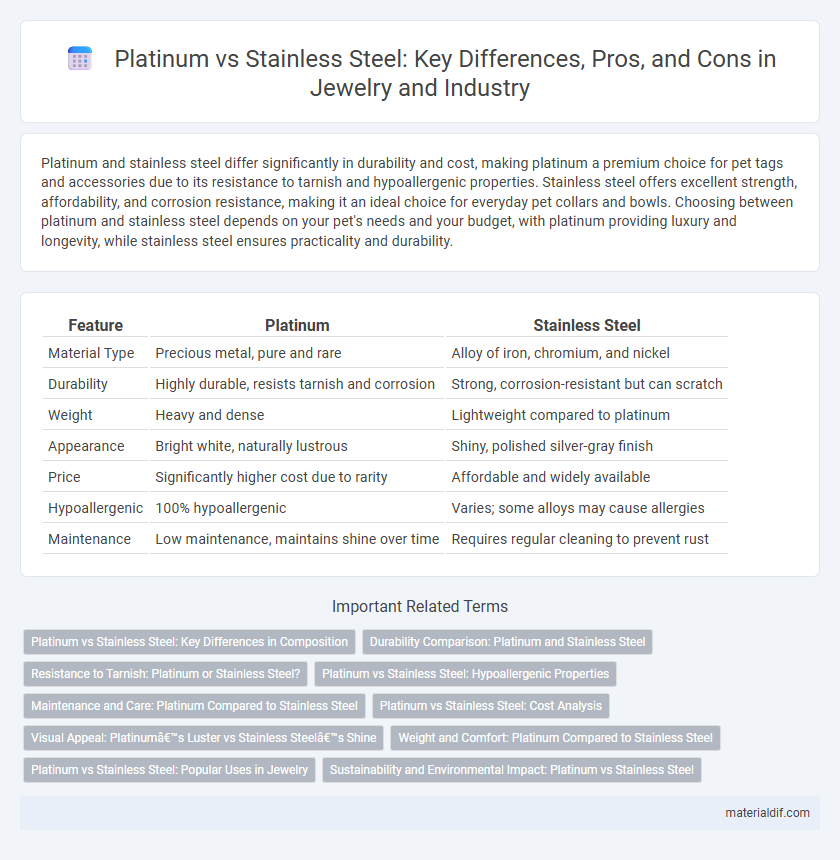Platinum and stainless steel differ significantly in durability and cost, making platinum a premium choice for pet tags and accessories due to its resistance to tarnish and hypoallergenic properties. Stainless steel offers excellent strength, affordability, and corrosion resistance, making it an ideal choice for everyday pet collars and bowls. Choosing between platinum and stainless steel depends on your pet's needs and your budget, with platinum providing luxury and longevity, while stainless steel ensures practicality and durability.
Table of Comparison
| Feature | Platinum | Stainless Steel |
|---|---|---|
| Material Type | Precious metal, pure and rare | Alloy of iron, chromium, and nickel |
| Durability | Highly durable, resists tarnish and corrosion | Strong, corrosion-resistant but can scratch |
| Weight | Heavy and dense | Lightweight compared to platinum |
| Appearance | Bright white, naturally lustrous | Shiny, polished silver-gray finish |
| Price | Significantly higher cost due to rarity | Affordable and widely available |
| Hypoallergenic | 100% hypoallergenic | Varies; some alloys may cause allergies |
| Maintenance | Low maintenance, maintains shine over time | Requires regular cleaning to prevent rust |
Platinum vs Stainless Steel: Key Differences in Composition
Platinum is a naturally occurring platinum group metal known for its high purity, typically 95% or higher, while stainless steel is an alloy primarily composed of iron, carbon, and chromium, with varying amounts of nickel and other elements. Platinum's dense atomic structure and resistance to corrosion make it more durable and heavier compared to stainless steel, which offers greater strength but is more prone to oxidation. The primary difference lies in platinum's elemental purity versus stainless steel's composite nature, influencing their applications in jewelry, industrial use, and corrosion resistance.
Durability Comparison: Platinum and Stainless Steel
Platinum offers superior durability due to its dense, malleable nature, resisting scratches, tarnish, and corrosion more effectively than stainless steel. Stainless steel, while tough and corrosion-resistant, is more prone to surface scratches and requires frequent maintenance to preserve its appearance. For long-term durability in jewelry and high-use applications, platinum remains the preferred choice due to its lasting strength and minimal wear over time.
Resistance to Tarnish: Platinum or Stainless Steel?
Platinum exhibits superior resistance to tarnish compared to stainless steel due to its inert chemical properties and high density, which prevent oxidation and discoloration. Stainless steel, while durable and corrosion-resistant, contains iron that can oxidize and cause rust or tarnish over time, especially in harsh environments. For applications where long-term luster and minimal maintenance are critical, platinum is the preferred material for maintaining a pristine appearance.
Platinum vs Stainless Steel: Hypoallergenic Properties
Platinum exhibits superior hypoallergenic properties compared to stainless steel, making it an ideal choice for individuals with sensitive skin or metal allergies. Unlike stainless steel, which may contain nickel or other alloys that can trigger allergic reactions, platinum is a naturally hypoallergenic metal that maintains its purity over time. This quality ensures less skin irritation and safer wear for jewelry or medical implants.
Maintenance and Care: Platinum Compared to Stainless Steel
Platinum requires less frequent cleaning and polishing than stainless steel due to its resistance to tarnish and corrosion, making it a low-maintenance option for jewelry and industrial uses. Stainless steel, while durable, needs regular cleaning to prevent rust and maintain its luster, especially when exposed to moisture or chemicals. Both metals benefit from gentle cleaning methods, but platinum's dense, non-porous surface makes it easier to care for over time.
Platinum vs Stainless Steel: Cost Analysis
Platinum is significantly more expensive than stainless steel, with prices often exceeding $1,000 per ounce compared to stainless steel's cost of just a few dollars per pound. The high cost of platinum is driven by its rarity, complex extraction process, and superior durability, making it a premium choice for jewelry and industrial applications. Stainless steel offers a cost-effective alternative with strong corrosion resistance and versatility but lacks the prestigious value and hypoallergenic properties of platinum.
Visual Appeal: Platinum’s Luster vs Stainless Steel’s Shine
Platinum's luster offers a unique, soft white glow that remains untarnished over time, creating a luxurious and timeless look. Stainless steel shines with a brighter, more reflective surface but can lose its brilliance through scratches and wear. The subtle elegance of platinum contrasts with the mirror-like finish of stainless steel, making it a preferred choice for high-end jewelry and sophisticated designs.
Weight and Comfort: Platinum Compared to Stainless Steel
Platinum is denser and heavier than stainless steel, providing a substantial and luxurious feel without compromising comfort for those accustomed to its weight. Unlike stainless steel, platinum's natural hypoallergenic properties reduce skin irritation, enhancing wearability for sensitive skin. Its durability combined with a smooth, heavyweight texture offers a premium comfort level that stainless steel often cannot match.
Platinum vs Stainless Steel: Popular Uses in Jewelry
Platinum is favored in fine jewelry for its rarity, hypoallergenic properties, and natural white luster that resists tarnish, making it ideal for engagement rings and luxury pieces. Stainless steel, known for its durability, corrosion resistance, and affordability, is commonly used in fashion jewelry, watches, and everyday accessories. While platinum offers a premium, elegant appeal, stainless steel provides a practical, budget-friendly option suited for casual and high-strength applications.
Sustainability and Environmental Impact: Platinum vs Stainless Steel
Platinum is a rare, naturally occurring metal with a high recycling rate, making it a sustainable choice for long-term use due to its durability and resistance to corrosion. Stainless steel, composed primarily of iron, chromium, and nickel, is also highly recyclable and commonly sourced from recycled materials but often requires more energy-intensive production processes. The environmental impact of platinum mining can be significant, though its longevity reduces the need for frequent replacement, while stainless steel's widespread availability and recyclability contribute positively to resource efficiency.
Platinum vs Stainless Steel Infographic

 materialdif.com
materialdif.com